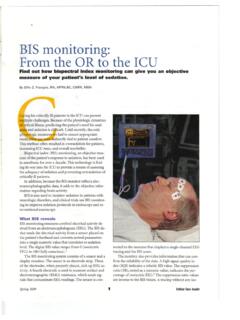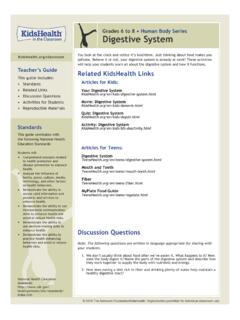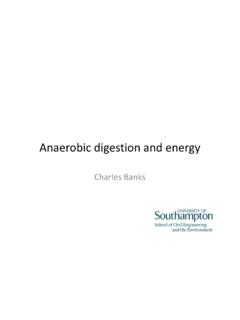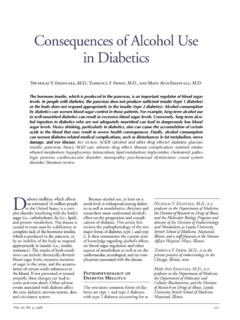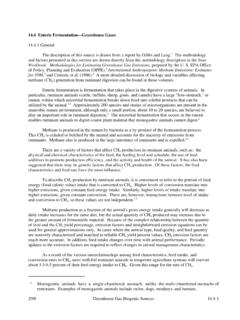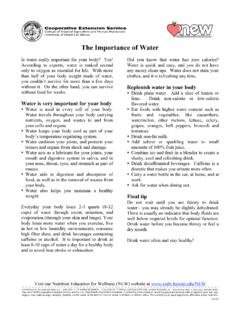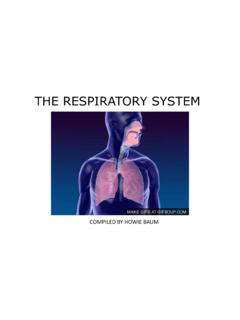Transcription of AUTONOMIC NERVOUS SYSTEM PHYSIOLOGY
1 HISTORICAL CONSIDERATIONSA specialized taxonomy of the AUTONOMIC NERVOUS SYSTEM (ANS) has been developing since the time of Galen (ad 130-200). In the early 1900s, Langley first referred to the He used the term sympathetic NERVOUS SYSTEM (SNS) as described by Willis in 1665, and introduced the second divi-sion as the parasympathetic NERVOUS SYSTEM (PNS) in Although Langely initially described only the visceral motor SYSTEM (efferent fibers), the existence of visceral reflex arcs necessitated the inclusion of the sensory (afferent) por-tions of the Early anesthesia textbooks dealt with the practice of anesthesia, elucidating basic considerations, pharmacology and techniques, but did not contain explicit information dealing with the ANS.
2 The evolution of the comprehensive anesthesia textbook has led to extensive chapters on the ,4 The ANS maintains cardiovascular, thermal, and gastro-intestinal homeostasis. A firm understanding of the basic anatomy and PHYSIOLOGY of the ANS forms an important foundation for the practice of anesthesiology. ANS structure, function, and reflexes are critical to the support of the circula-tion under anesthesia. This chapter reviews anatomy and PHYSIOLOGY of the ANS relevant to AND PHYSIOLOGYANS anatomy is comprised of central control and feedback areas, sensory receptors, peripheral effectors, and reflex con-duction pathways. In addition, complex interactions occur between the ANS and the endocrine SYSTEM (Chapter 30).
3 4 The renin-angiotensin SYSTEM , antidiuretic hormone, gluco-corticoid and mineralocorticoid responses, and insulin inter-act via an increasing number of receptor subtypes to maintain physiologic homeostasis (Figure 12-1).There are no distinct centers of AUTONOMIC function in the cerebral cortex. However, input from various sensory systems can impact higher cortical centers, be processed, and result in efferent AUTONOMIC activity. Tachycardia and peripheral vaso-constriction heralding a fight-or-flight response or a vaso-vagal response (fainting) are well-known examples of this higher cortical sensory External stimuli repre-senting a threat or danger are detected by the senses of hearing, touch, smell, or sight.
4 These signals are sent to the AUTONOMIC NERVOUS SYSTEM PHYSIOLOGYJoel O. JohnsonChapter 12 HISTORICAL CONSIDERATIONSANATOMY AND PHYSIOLOGYS ympathetic NERVOUS SystemParasympathetic NERVOUS SystemCELLULAR PHYSIOLOGYP reganglionic NeuronsPostganglionic NeuronsSecond Messengers in the AUTONOMIC NERVOUS SystemAUTONOMIC NERVOUS SYSTEM REFLEXESC entral NERVOUS SYSTEM ReflexesCardiac ReflexesEMERGING DEVELOPMENTSE ffects of Anesthetics on AUTONOMIC NERVOUS SystemAutonomic FailureChapter 12 AUTONOMIC NERVOUS SYSTEM PHYSIOLOGY209from nuclei like the nucleus tractus solitarius maintain blood pressure and respond to afferent signals from the sensory side of the ANS. These afferent impulses from the vagus (X) and glossopharyngeal (XI) nerves result in vasodilation and bra-dycardia (see section on ANS reflexes).
5 The ANS is anatomically and functionally divided into two complementary systems, the SNS and the PNS (see Figure 12-1). The peripheral SNS is controlled by the thoracolum-bar segment of the spinal cord, while PNS control arises from the brainstem nuclei and sacral segments (see Figure 12-1). Activation of the SNS produces diffuse physiologic responses, while the PNS exerts local control of innervated systems have efferent pathways through peripheral ganglia; the SNS ganglia are located close to the thoracolum-bar spine, and the PNS ganglia are situated near or inside the innervated organs (see Figure 12-1; Figure 12-2). Ganglia serve as synaptic relay stations, and in the SNS coordinate an efferent mass action response through signal amplification.
6 Thus one preganglionic SNS fiber can activate 20 to 30 post-ganglionic sympathetic neurons and their fibers. In contrast, PNS preganglionic fibers terminate in ganglia located in brainstem, where reflex responses are processed in the hypo-thalamus and the limbic forebrain. Higher cortical centers provide descending input to the paraventricular nucleus of the hypothalamus, which has projections to sympathetic and parasympathetic nuclei. Chronic stress alters these structures and their function leading to both sensitization and habitua-tion of the stress ,7 The hypothalamus is the midbrain center that processes sympathetic and parasympathetic functions, temperature reg-ulation, fluid regulation, neurohumoral control, and stress responses.
7 Hunger, sleep, and sexual function are also regu-lated by the hypothalamus, dependent upon both cortical input and complex feedback control. The anterior hypothala-mus controls temperature, while the posterior hypothalamus is involved in water regulation. The hypothalamic-pituitary axis is a part of the ANS that ultimately regulates long-term blood pressure control and stress output centers of the ANS reside in the medulla oblongata and the pons of the brainstem. Immediate control of blood pressure, heart rate, cardiac output, and ventilation is organized and integrated in specific nuclei. Tonic impulses Figure 12-1 Schematic representation of the AUTONOMIC NERVOUS SYSTEM consisting of the parasympathetic NERVOUS SYSTEM (left) and the sympathetic NERVOUS SYSTEM (right).
8 EyeCiliaryganglionSuperior cervical ganglionMiddle cervical ganglionCeliacganglionGreatersplanchnicn erveLessersplanchnicnerveSuperiormesente ricganglionInferior mesentericorpelvic ganglionTo lower gut andgenitourinary organsTo the intestinesPancreasto upperGI organsStellate ganglion (inferior cervical)To the thoracic viscera, heartAdrenalsKidneysSphenopalatinegangli onSphenoplalaticganglionBronchi, lungs,and esophagusStomachand spleenIntestines andupper colonLiverKidneysPelvic ganglionDescending colon,rectum, andgenitourinary organsPelvic plexusL1-5T1-12T123456789101112L12345S1- 5C1-8 XXIVIIIIICo1-2 Parasympathetic NERVOUS SYSTEM (PNS)(craniosacral outflow)Sympathetic NERVOUS SYSTEM (SNS)(thoracolumbar outflow)Pancreas andadrenalsHeartOtic ganglionPreganglionic fibersPostganglionic fibersLacrimal glandParotid glandSubmandibular andsublingual glandsSection II NERVOUS SYSTEM210variable distance up or down the sympathetic chain to synapse with the neuronal cell bodies of postganglionic sympathetic neurons.
9 The unmyelinated postganglionic fibers then inner-vate their respective organs. An exception to this rule is the adrenal gland, where the preganglionic fibers do not synapse in the thoracic ganglia, but course through the sympathetic chain into the adrenal medulla. The chromaffin cells in the adrenal medulla are derived from neuronal tissue and essen-tially function as the postganglionic stellate ganglion consists of postganglionic neurons that provide sympathetic innervation to the head and neck. Preganglionic fibers from the first four or five thoracic seg-ments form this ganglion as well as the superior cervical and middle cervical ganglia. Blockade of this structure with local anesthetic blocks the sympathetic fibers coursing to the ipsi-lateral head and neck, resulting in Horner syndrome, charac-terized by ptosis, miosis, enophthalmos, and anhydrosis on the affected This syndrome would be seen as a direct effect of a stellate ganglion block and possibly be experienced as a side effect of a brachial plexus block due to its close proximity to the stellate Similarly, blockade of the lumbar plexus produces a sympathectomy in the lower extremities.
10 And peripheral nerve block often produces a sym-pathectomy in the affected limb because the postganglionic sympathetic nerve fibers travel along the somatic 12-2 Differences between the location of the ganglia in the sym-pathetic and parasympathetic branches of the AUTONOMIC NERVOUS SYSTEM . The 22 paired sympathetic ganglia are located close to the vertebral column in the sympathetic chain. The unmyelinated postganglionic fibers innervate their respective organs. The exception is the adrenal gland, where the sym-pathetic preganglionic nerve fibers travel directly to the adrenal medulla. The parasympathetic preganglionic fibers travel directly to the organ of innervation, to synapse with postganglionic neuronal cell bodies.
